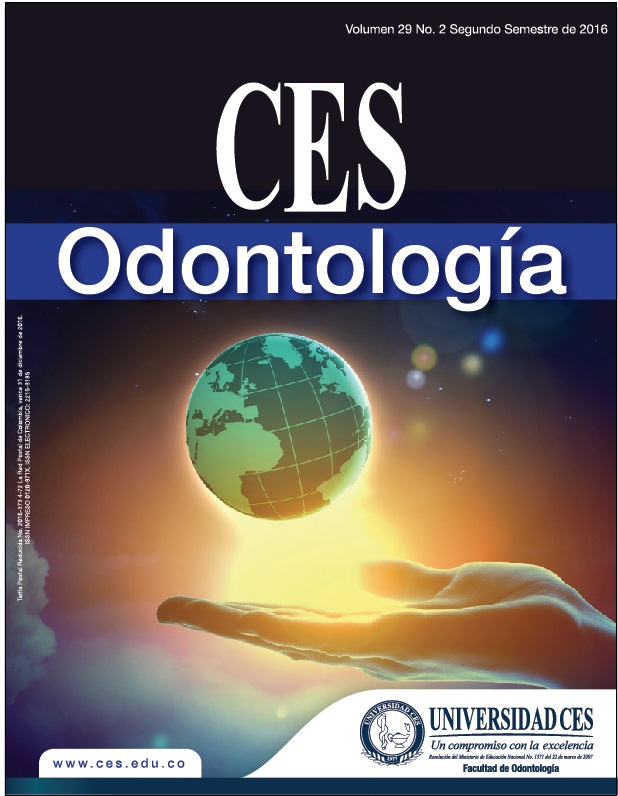Comparison of the dental leakage between Ketac™ Molar e Ionofil Molar® with centrix and ART spatula
Abstract
Introduction: Atraumatic restorative treatment is used as part of preventive public health programs, so it is important to evaluate the application techniques of restorative material. Objective: Compare the microleakage of the Ketac ™ Molar Easy Mix and Ionofil Molar® between two application techniques: Centrix syringe and spatula TRA. Materials and methods: Experimental in vitro study. 52 teeth of bovine with cavity preparations were used. The teeth were divided into 2 groups according to ionomer cements, also were subdivided, according to the technique. The restorative material was placed following the manufacturer’s instructions. All teeth were thermocycled, immersed in methylene blue 0.05% and sectioned. It was evaluated with an esteromicroscopio software. To compare the application techniques according the ionomer cements were used statistical tests: Student t test and Mann-Whitney U. Results: The microfiltration of Ketac ™ Molar Easy Mix and Ionofil Molar® ionomeric cements according to centrix syringe and TRA spatula application techniques showed no statistically significant differences (p value> 0.05). The Ketac TM Molar Easy Mix cement and the technique with the centrix syringe were those that presented less microfiltration. Conclusion: All teeth presented microfiltration and among them the group KetacTM Molar Easy Mix® with centrix syringe showed lower values of microfiltration.
Downloads
References
2. Perú. Ministerio de Salud. Norma Técnica N° 036 de 2005, nov 17, Atenciones odontológicas básicas en poblaciones excluidas y dispersas. Lima: El Ministerio; 2005.
3. Navarro M, Bresciani E. Tratamiento Restaurador Atraumático: Una revisión de la Literatura desde el desarrollo hasta las perspectivas futuras-parte 1. Rev Dent Chile. 2003; 94(2):26-30.
4. Molina G, Cabral R, Jo F. The ART approach clinical aspects reviewed. J Appl Oral Sci. 2009; 17: 89-98.
5. Davidson C. Avances en cementos de Ionómero de Vidrio. J Appl Oral Sci. 2006; 14: 3-9
6. Pitel M. Reconsidering Glass- Ionomer Cements for Direct Restorations. Compendium. 2014; 35(1):26-31.
7. Koshy G, Joshi J. Comparative Evaluation of the Microleakage of Two Modified Glass Ionomer Cements on Primary Molars. An In Vitro study. J Ind Soc Pedodont and Preven Dent. 2011; 29 (2):135-9.
8. Kemoli A. The Effects of ambient temperature and mixing time of glass ionomer cement material on the survival rate of proximal ART restorations in primary molars. Contemp Clinic Dent. 2014; 5(1):31-6.
9. Webber R, Del Rio C, Brady J, Segall R. Sealing quality of a temporary filling material. Oral Surg Oral Med Oral Pathol. 1978; 46: 123–30.
10. Abuabara A, Souza A, Baggio F, Lovadino J. Evaluation of microleakage in human, bovine and swine enamels. Braz Oral Res. 2004; 18 (4):312-6.
11. Baena M, Gonini A, Moura S, McCabe J. Comparison of microleakage in human and bovine substrates using confocal microscopy. Dent Coll. 2009; 50(3):111-6.
12. Tascón J. Restauración Atraumática para el control de la caries dental: Historia, características y aportes d la técnica. Rev Panam. 2005; 17(2):110-5.
13. Fracasso M, Rios D, Machado M, Silva S, Abdo R. Evaluation of Marginal Microleakage and Depth of Penetration of Glass Ionomer Cements used as Occlusal Sealants. J Appl Oral Sci.2005; 13(3):269-74.
14. Ortega P, Barceló F, Pacheco M, Ramírez F. Adhesión y microfiltración de dos selladores de fosetas y fisuras con diferente sistema de polimerización. Rev Odontol Mex.2007; 11(2):70-5.
15. Jiménez A, Yamamoto A. Valoración de la microfiltración del ionómero de vidrio mejorado (Ketac Molar Easy Mix®) con o sin el uso de acondicionador. Rev Odon Mex. 2015; 19(3):170-3.
16. Barragán N. Comparación in vitro de la microfiltración marginal y la profundidad de penetración entre dos selladores de fosas y fisuras de cemento de ionómero de vidrio y un sellador polimérico, con y sin ameloplastía [Tesis]. Lima: Universidad Peruana Cayetano Heredia. Facultad de Odontología; 2013.
17. Raggio D, Bonifacio C, Bonecker M, Imparato J, Gee J, Amerongen E. Effect of insertion method on knoop hardness of high viscous glass ionomer cements. Braz Dent J.2010; 21:439 -45.
18. Okada K, Tosaki S, Hirota K, Hume W. Surface hardness change of restorative filling materials stored in saliva. Dent. Mat 2001; 17: 34-9.
19. Yassen G, Platt J, Hara A. Bovine teeth as substitute for human teeth in dental research: a review of literature. Journal Oral Sci. 2011; 53(3):273-82.
20. Cunha I, Bazhouni T, Chacur N, Fabricio R, Sayao M. Bovine teeth as possible substitute to human teeth in laboratory studies: current findings reviewed. UFES Rev Odontol. 2008; 10(2):58-63.
Downloads
Published
How to Cite
Issue
Section
| Article metrics | |
|---|---|
| Abstract views | |
| Galley vies | |
| PDF Views | |
| HTML views | |
| Other views | |



